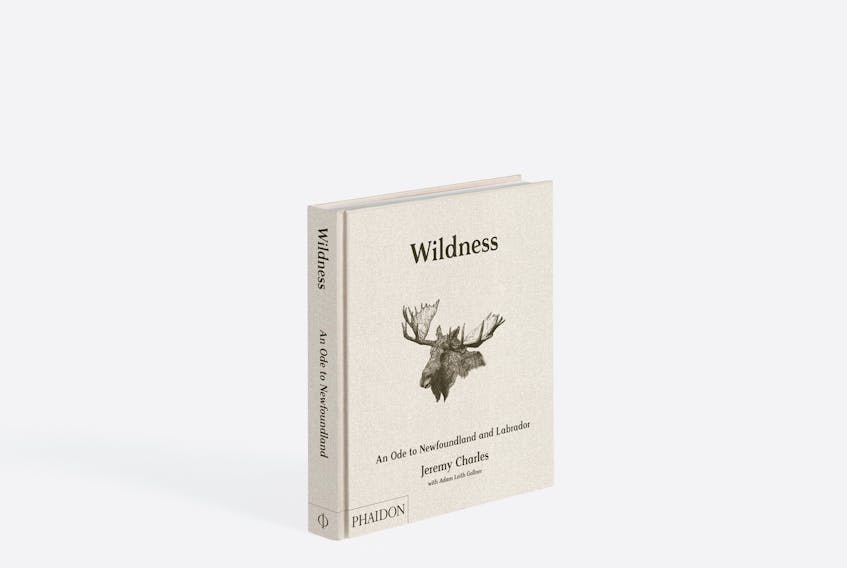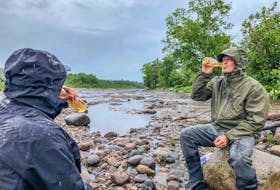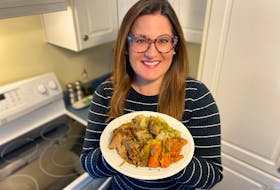The tenor of “Wildness” is set from its opening pages of landscape photography, and a shot of Jeremy Charles situated very much in that landscape, leading to the first verse of the “Ode to Newfoundland.” This is a cookbook, yes, but one framed by specific geography and personal story.

Charles and Jeremy Bonia opened Raymonds (named for the former’s grandfather and the latter’s father) in November 2010. The path that brought them there is an interesting one, and Charles charts it — how Newfoundland cuisine was steeped into his family life and, though he came relatively late to studying cooking professionally, the vocation was an immediate fit. And Raymonds is a phenomenon; among its accolades, Diner’s Club ranks it as one of the best 50 restaurants in the world. (The world!) Charles doesn’t tarry amidst the hype, though, instead concentrating on the ethos Raymonds is built on. “We develop our menus based on what we have at that very moment: it’s reactive cooking. We live in one of the only places in North America where wild game can be served in restaurants.”
Zita Cobb, in her Foreword, remembers the first meal she had prepared by Charles: “What Jeremy presented that evening was nothing short of path-affirming. Delicious, inventive, satisfying? Obviously. But more importantly it demonstrated what was possible…”
The food was more than meat and vegetables and seafood and fruit on a plate. It, very deliberately, embodied a culture.
As Cobb notes, Charles’ methods and mindset is about a sense of place, and of home, a knowing not just of the natural world but of the processing and accessing of it though growing and hunting and foraging, and “how to hold on to all these ways of knowing.”
As Charles writes, “I want this book to give a sense of just how rich this province’s food culture is.”
Next, Adam Leith Gollner’s “Off the Land” begins with a quote from Bernice Morgan’s “Random Passage.” That’s apt, as this article concerns the Newfoundland vernacular — “A meal is a scoff. When you eat, you’re ‘having a feed.’ If you are gutfounded, you’re hungry” — and other aspects of our culinary legacy.
As Charles notes, “I started out cutting cod tongues as a kid and I still love being elbow-deep in wild food.”
The books categories include “Cod,” “Small Game,” “Seafood,” “Farm Animals,” “Moose,” “Desserts,” “The Newfoundland Larder” and “The End of the Night.”
These are further delineated. For example, “Cod” includes “Fish and Brewis,” “Scrunchions and Drawn Butter,” and “Roasted Cod Nape, Rutabaga Purée and Onion Crisp.” Each recipe begins with a personal note from Charles —– “Fish and brewis is my death-row meal,” or a nod to his first date with his wife, or an explanation of cod sounds. Ingredients are listed alongside his own instructions, and illustrated with full page, full colour photos. (There are 120 colour illustrations, making them almost half the book.)
Shorter personal essays, from authors including visual artist/musician Boyd Chubbs, Inuit polar bear hunter Paul Jararuse, and Bonia’s “On Pairing Wild Food and Wine,” further pace and partition the sections.
“Small Game” includes partridge, rabbit, grouse, turr, duck, and “Seal Carpaccio, Alder, Juniper, and Partridgeberries”; “Shellfish” whelk, scallops, razor clams, shrimp, and sea urchins; “Farm Animals” lamb, pork, and beef. The breadth of unexpected and gorgeous sources and pairings is really striking: “Split Pea Doppio and Smoked Pork Broth,” anyone?
There are 10 recipes for moose, using the heart, marrow, tongue, cheeks and chop, producing charcuteries, consommé and pappardelle.
The 17 dessert recipes include blueberries, bakeapples and molasses, and also “Candied Parsnips,” “Vinegar Pie,” and “Black Sesame and Sea Urchin Macaron.”
“The Newfoundland Larder” includes 66 entries, for example: “Scotch Lovage Vinaigrette”: “250 ml Scotch lovage oil/75 ml apple cider vinegar/2 pinches sea salt/Put everything into a bottle and shake well.”
Gollner’s “The End of the Night” brings us to Labrador, the Torngats and the Northern Lights. “Locals believe that it’s dangerous to whistle or whisper around an aurora; Inuit spirits were thought to communicate by whistling. According to Inuit lore, an aurora can come right up to anyone who knows how to beckon it.” There’s an Index, as well as Recipe Notes and Measurement Notes.
In terms of representing the wealth of Newfoundland’s food culture, this publication succeeds to the extent that a reader (me) who can’t cook for beans (definitely me) is fascinated. I can only imagine that a real chef/foodie would be salivating at the opportunity to deep dive into this learned, personable, delectable text.
Joan Sullivan is editor of Newfoundland Quarterly magazine. She reviews both fiction and non-fiction for The Telegram.
RELATED:









